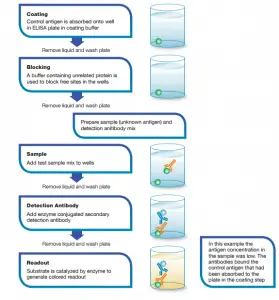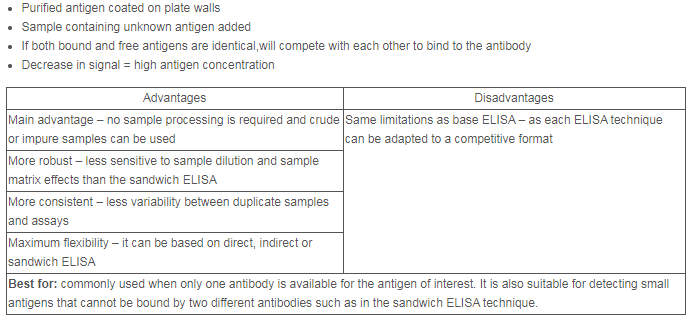ELISA Assay Development
Principles
The Enzyme-Linked ImmunoSorbent Assay, or ELISA, is a technique used to detect the presence of a specific molecule in a given sample. The molecule to be detected could be an antibody or antigen.
Basically, a small plastic well is coated with an antibody that binds to the antigen of interest (for example, a toxin). Sample is added to the well. If the toxin is present, it binds to the antibody and sticks to the well surface. The samples are rinsed to remove any unbound material. Another anti-toxin antibody is added. Then a tagged antibody is added; this one has an enzyme attached to one end. The substrate of the enzyme is then added. If the enzyme is there, the substrate gets converted to a colored product, and we can see it as a positive result.
Procedure
- The surfaces of the wells in the plate are coated with a “capture” antibody.
- The sample is then added and any antigen present binds to the capture antibody. After washing the plates, only the antibody-antigen complexes remain attached to the well.
- A second antibody (“detecting” antibody) which will bind to any antigen-antibody complexes is added to the wells.
- An enzyme-linked secondary antibody is added. This antibody recognizes the detecting antibody.
- After washing the plates again, all the excess antibody will be removed. Finally a substrate that reacts with the enzyme is added to provoke a chromogenic or fluorescent signal. Positive reactions are detected by color in the wells.
Elisa Advantages
- Versatile: Many systems using different combinations of reagents can be used. Allows passive immobilization of reagents to a solid phase and easy separation of bound/unbound reactants using washing steps.
- Simple: Multiple samples can be tested in a variety of formats using microtiter plates and compatible equipment that provides high capacity, rapid and inexpensive assays feasible to kit development.
- Sensitive: Readouts come from enzyme catalysts or fluorescent tags that amplify signal efficiently and provide range of detection optimal for critical assays including diagnostics.
- Quantitative: Signal is detected by multichannel spectrophotometers and therefore the collected data can be stored and analyzed statistically.
Elisa Disadvantages
- The most important disadvantage in the ELISA for cholera toxin is the cross reaction that it displays with other similar toxins. Specifically this technique shows cross reactivity with heat-labile toxin from E. coli.
- The technique requires some additional reactions and equipment (ELISA lector) that could make it expensive.
The enzyme linked immunosorbent assay (ELISA) is used for the detection and quantification of proteins typically secreted or released from cells. Immobilizing a target-specific capture antibody onto a high protein binding capacity ELISA plate enables capture of target protein. The captured protein is then detected by a protein-specific biotinylated antibody. The target protein is quantified using a colorimetric reaction based on activity of avidin-horseradish peroxidase on a specific substrate. The optical density of the end-product is measured using a spectrophotometer. eBioscience offers a variety of ELISA to cytokines, chemokines,growth factors and protein released upon cell death.
Types of ELISA (Direct, Indirect, Sandwich, Competitive)
1. Direct Assay: It is the simplest configuration in which the antigen is bound by passive adsorption to the solid phase, washed to remove any unbound molecules and then directly incubated with a conjugated antibody. Following the incubation period and additional washing, substrate is added to produce signal that is allowed to develop. After certain time, the substrate reaction is stopped and the resulting signal quantified. It is commonly used for tittering conjugated secondary antibodies and very useful to estimate antigen cross-reactivity.
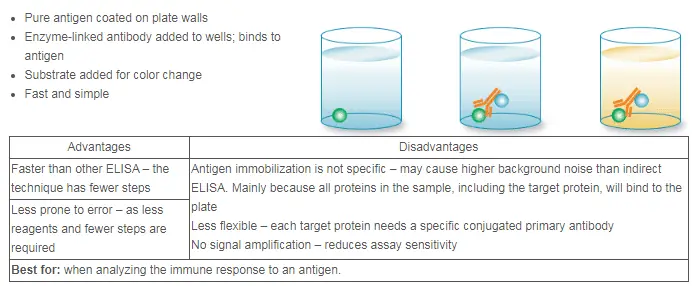
2. Indirect Assay: In this system, initial antigen binding and washing steps are the same as the direct method. The main difference in this case is the use of unconjugated antibody to bind the immobilized antigen upon incubation at optimal temperature (usually 37⁰C). Following a washing step to remove unbound antibodies, the remaining antigen-bound antibodies are targeted by a conjugated secondary antibody that will generate the readout signal as described for direct ELISA. This system has been widely applied in diagnostics because it allows large number of samples to be screened with a single conjugated secondary antibody.
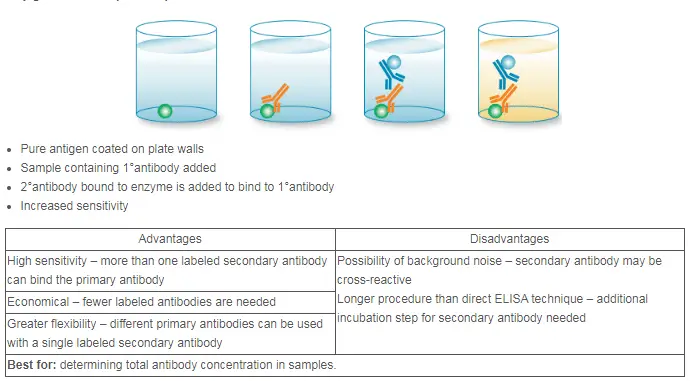
3. Sandwich Assay: This assay requires a compatible antibody pair that recognize different antigenic targets (epitopes) on the same antigen. The first antibody, called capturing antibody, is coated on the plate and used to immobilize the antigen upon binding during incubation with the sample. Free antigen is removed by a washing step and then a detecting antibody is added to bind the captured antigen and enable subsequent detection.
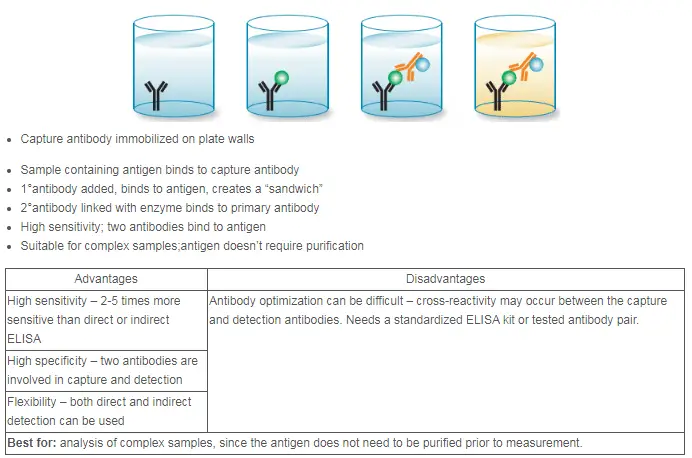
4. Competitive Assay: Each of the core systems described above can be further modified to measure molecules based on their ability to interfere with a well-known pre-titrated assay. Such assays can be used to study either antigens or antibodies and they can be competitive or inhibitory based on the specific conditions of each assay. In both types of assays, a pre-titrated system is challenged with the presence of the testing sample whose binding activity is then determined from the degree of the resulting interference in the established system.
